Bài giảng Introduction to Computer Programming (C language) - Chapter 8: Pointers - Võ Thị Ngọc Châu
Content
Introduction
Declare and initialize pointers
Operations on pointers
Pointers and arrays
Variable storage and heap memory
Memory allocation and de-allocation
Pointers and structures
Pass pointers to a function
Function pointers
Summary

Trang 1
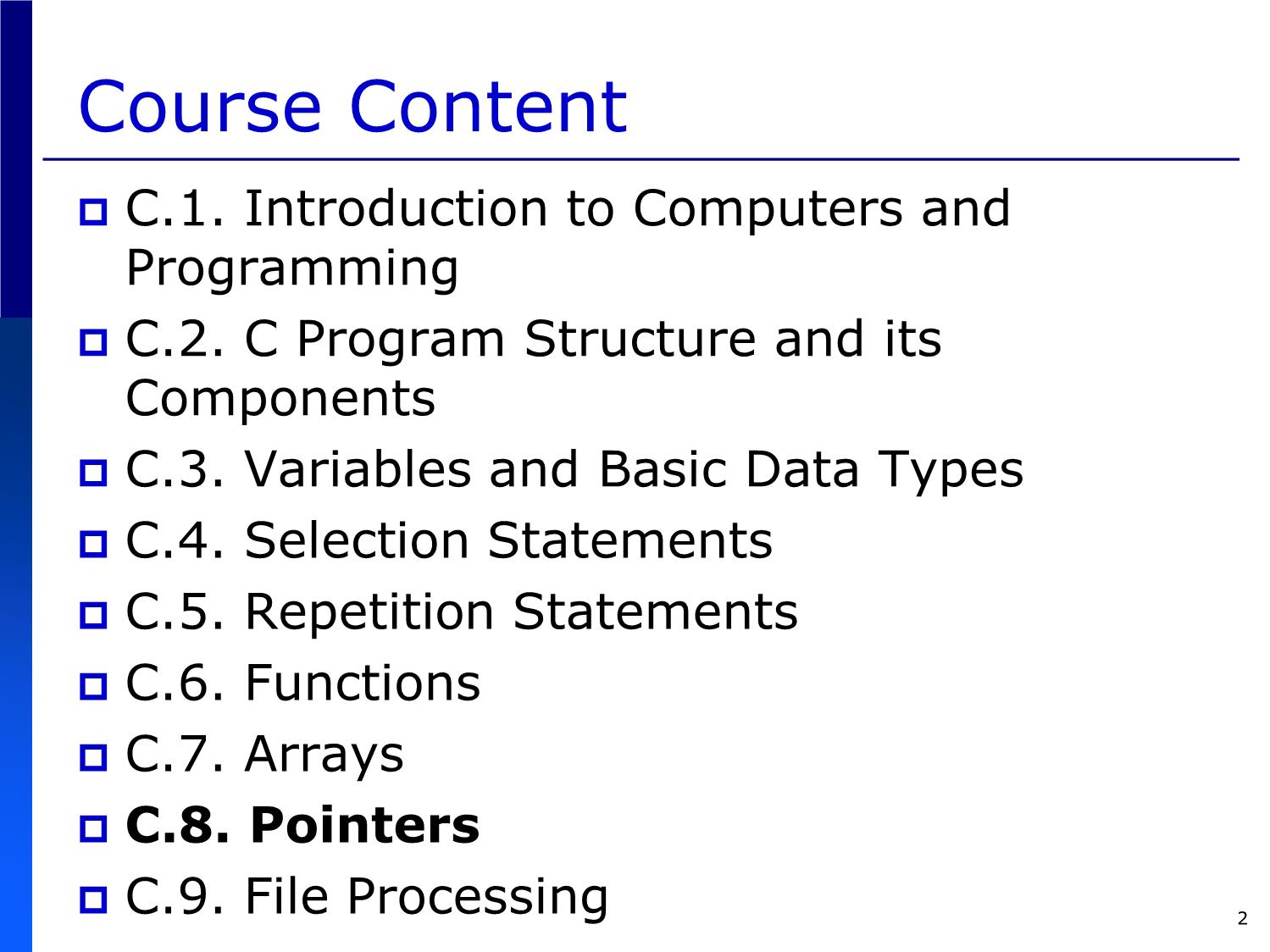
Trang 2
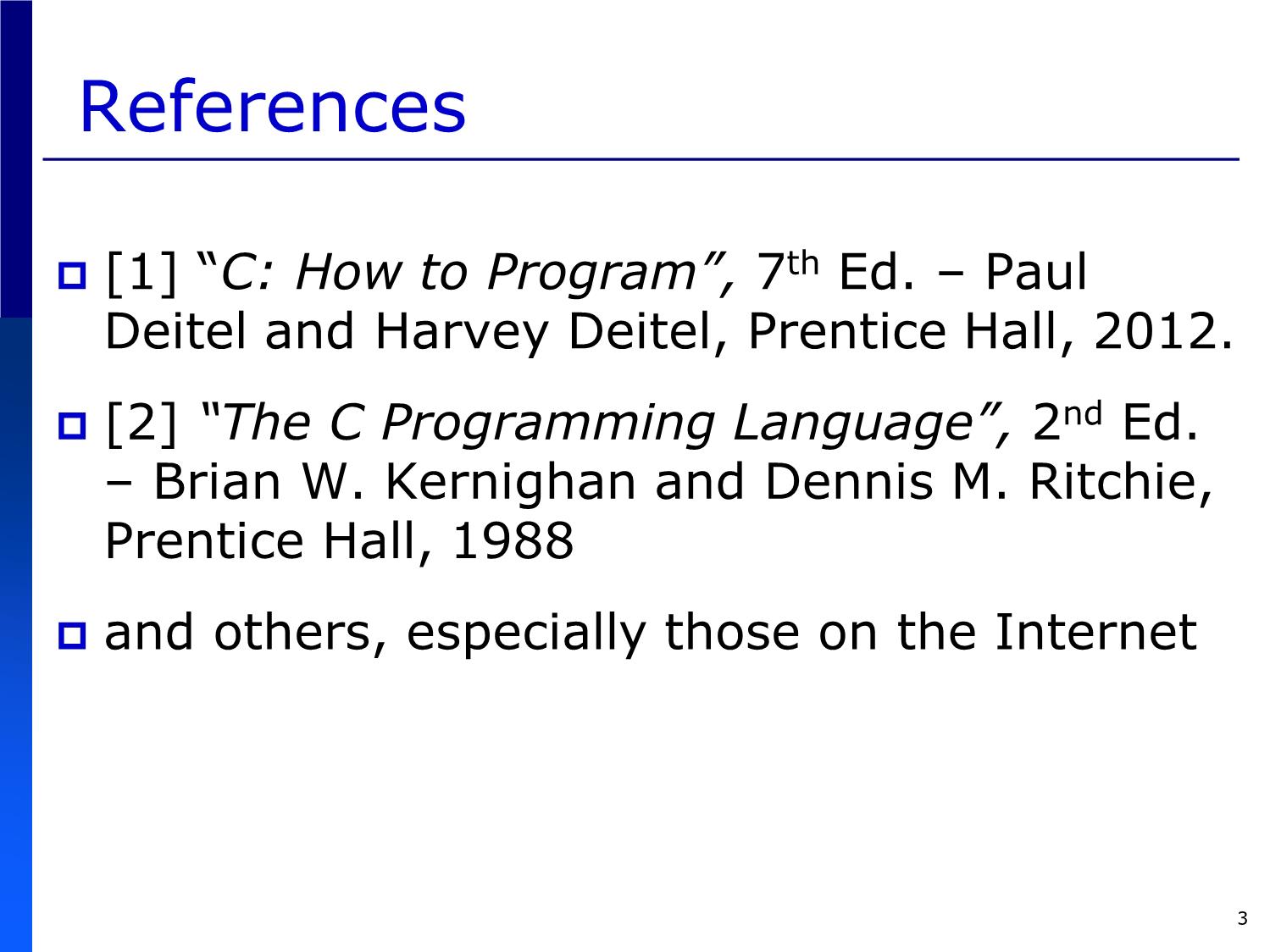
Trang 3
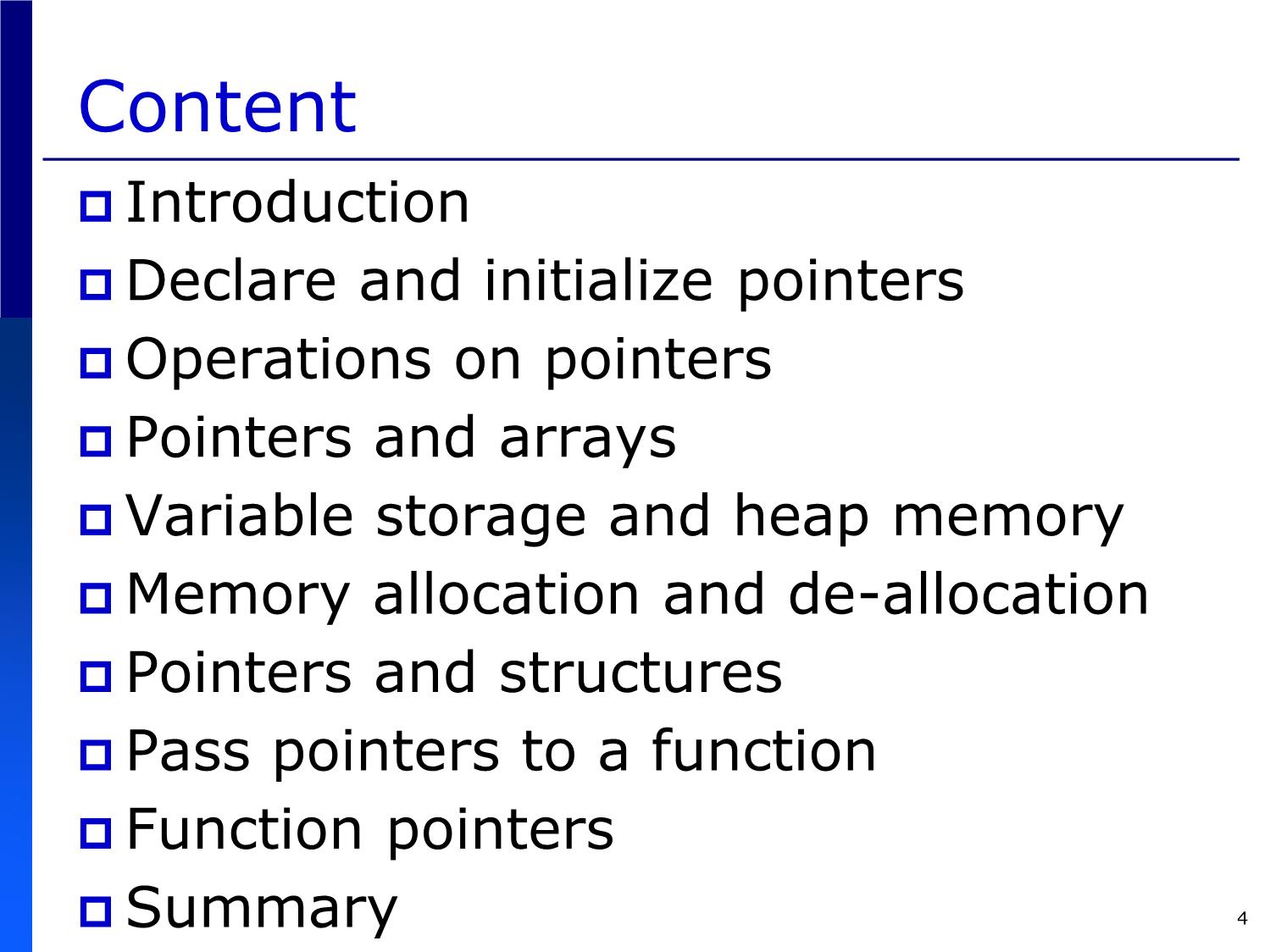
Trang 4
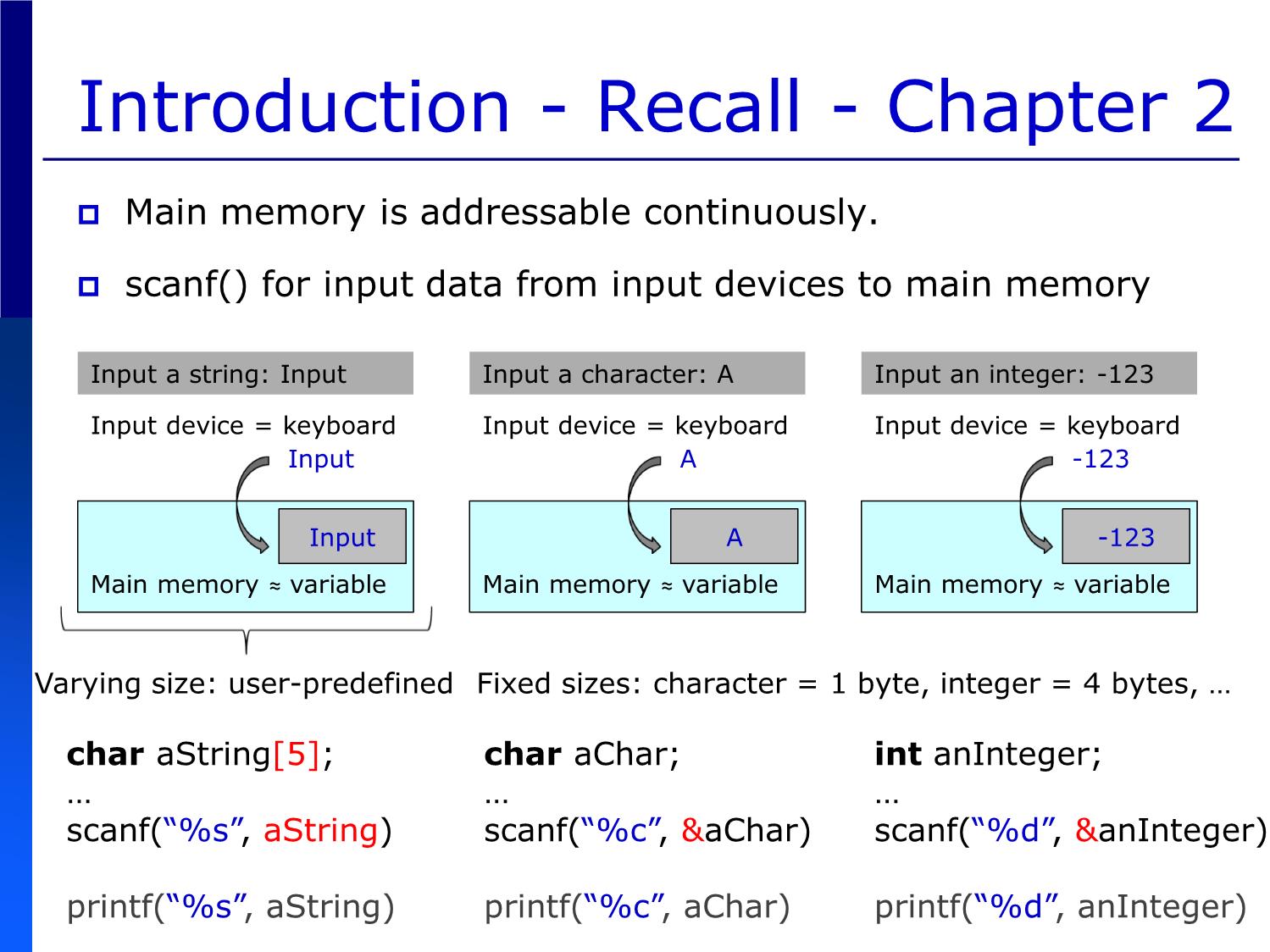
Trang 5
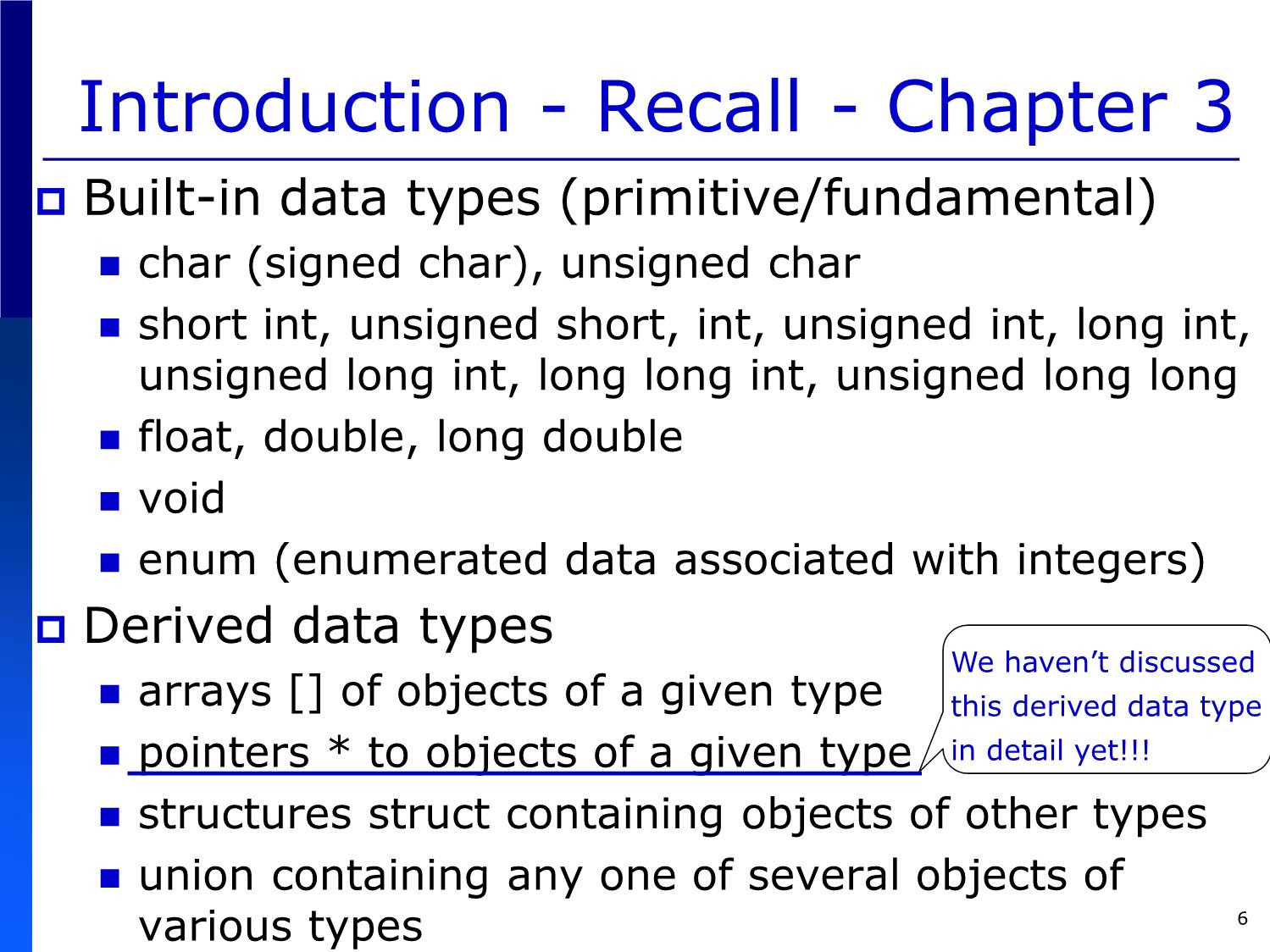
Trang 6
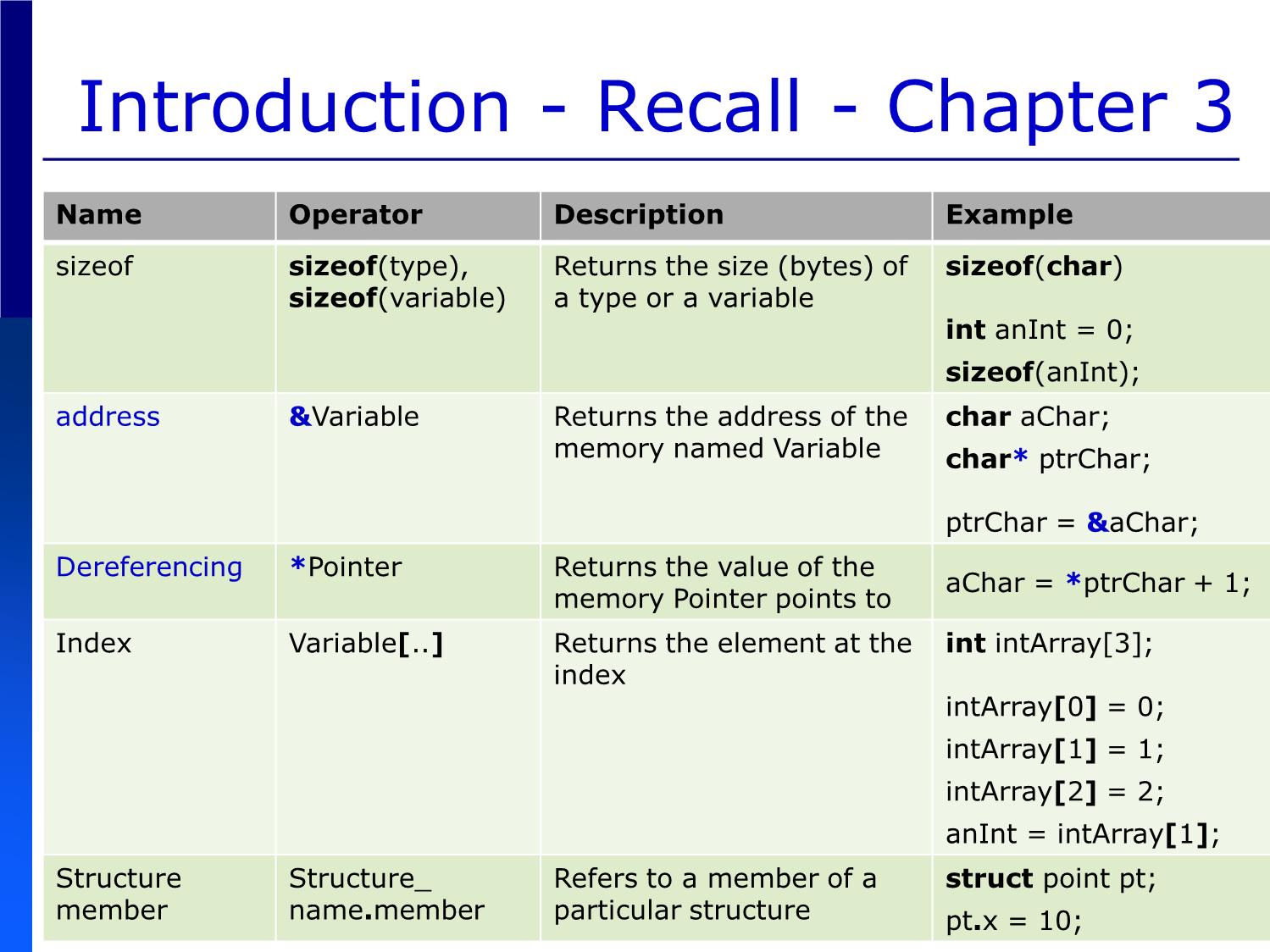
Trang 7
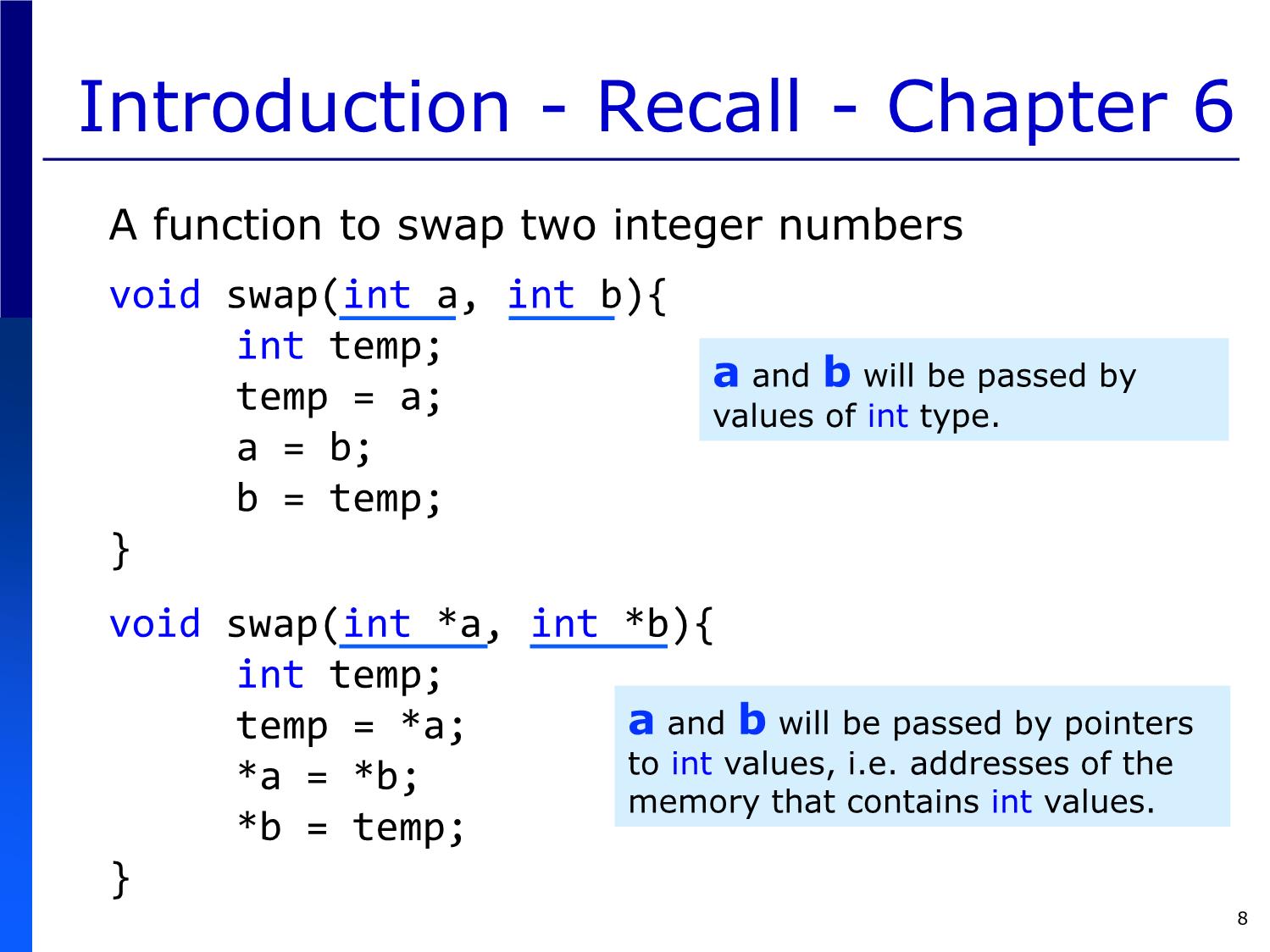
Trang 8
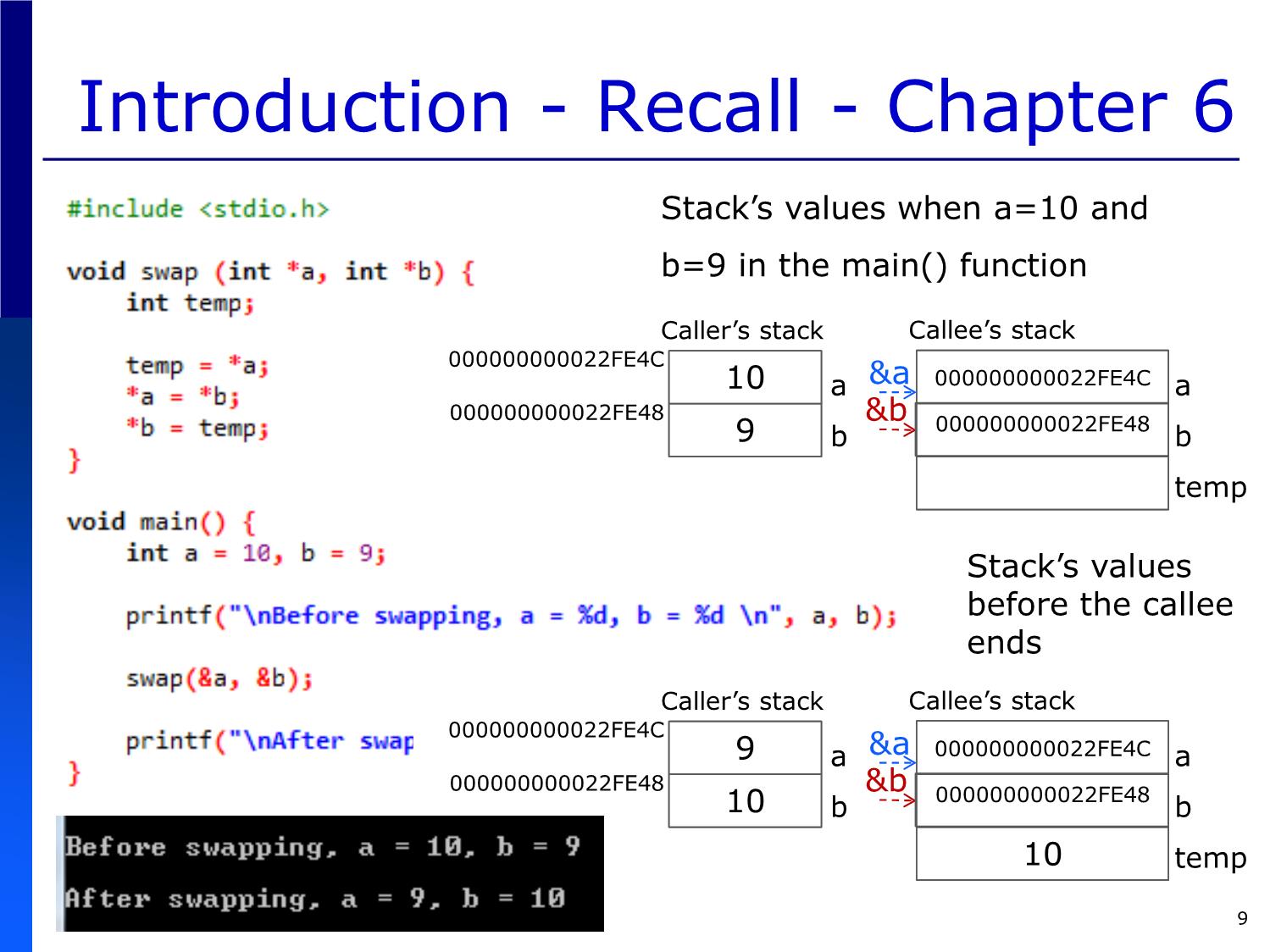
Trang 9
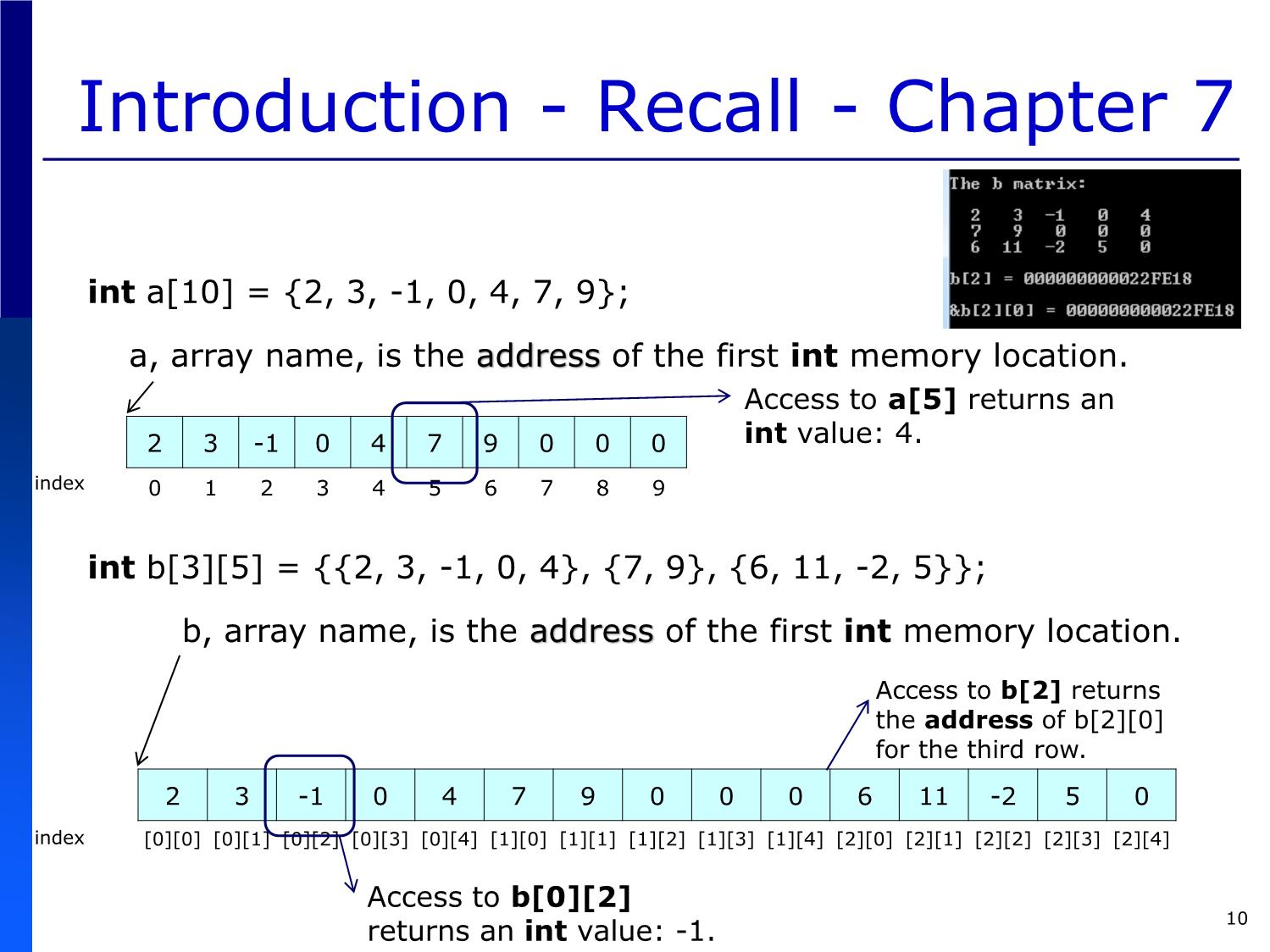
Trang 10
Tải về để xem bản đầy đủ
Bạn đang xem 10 trang mẫu của tài liệu "Bài giảng Introduction to Computer Programming (C language) - Chapter 8: Pointers - Võ Thị Ngọc Châu", để tải tài liệu gốc về máy hãy click vào nút Download ở trên
Tóm tắt nội dung tài liệu: Bài giảng Introduction to Computer Programming (C language) - Chapter 8: Pointers - Võ Thị Ngọc Châu
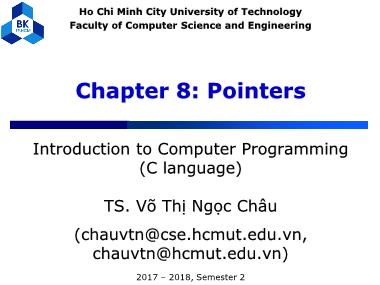
Attemps to resize the memory block pointed to by ptr that
was previously allocated with a call to malloc or calloc
De-allocation
void free(void* ptr)
De-allocates the memory previously allocated by a call to
calloc, malloc, or realloc 43
Define an array of 5 integer
numbers in heap memory
Allocation
Check if OK
Allocation
Check if OK
USE
De-Allocation
De-Allocation 44
Memory allocation and
de-allocation
Type casting The number of bytes to be allocated
for the appropriate data type of = the number of memory units * memory unit size
each value in a memory unit
Type casting The number of Memory unit size
for the appropriate data type of memory units
each value in a memory unit
5 memory units
Memory to be allocated
An integer value ? ? ? ? ? Memory unit size of an integer
4 bytes 4 bytes 4 bytes 4 bytes 4 bytes = 4 bytes
Memory allocation and
de-allocation
Memory layout
Stack pA pB i ?
Zero-filled
Heap ? ? ? ? ? 0 0 0 0 0 bytes with
calloc
Uninitialized data
.bss
Initialized data
.data
Code
.text
46
Calculate an averaged grade of the
courses you have taken. It is noted
that the number of courses might be
different from student to student.
47
Memory allocation and
de-allocation
Define an array of integer numbers in the stack: a[i]
Define an array of integer numbers in the heap: *(pA+i)
48
Memory allocation and
de-allocation
A static array not in heap
Memory layout
Stack a 1 2 3 4 5 pA i ?
A dynamic
array in
heap
Heap ? ? ? ? ?
Uninitialized data
.bss
Initialized data
.data
Code
.text
49
Memory allocation and
de-allocation
What are the differences?
A static array A dynamic array
Allow initialization at No initialization at
declaration of array declaration of pointer
Access via array name Access via pointers
Possible addresses Possible indices from zero
Located not in the heap Located in the heap
Fixed size thru existence Varying size with realloc
No extra storage Extra storage for pointer
No need to free the Need to free the memory
memory location location via pointer
sizeof(array name): sizeof(pointer): pointer
array size in bytes size, not array size 50
Memory allocation and
de-allocation
Strings are one-dimension arrays of
characters ended by „\0‟.
Strings can be dynamically allocated in the
heap memory via pointers.
The length of a string is not required to be
known in advance.
The length of a string can be varied.
Allocation: One extra byte is needed for „\0‟.
Use: char* aString;
Instead of: char aString[10];
or char aString[] = “a string”; 51
s3: a pointer points to an array of
characters ended by „\0‟ in the heap
a dynamic string: an array of
characters ended by „\0‟ in the heap
(char*)calloc(length+1, sizeof(char))
s3: a pointer points to a dynamic string
a dynamic string: resized in the heap
(char*)realloc(pointer, (length+1)*sizeof(char))
char s1[] = “Computer”;
char s2[] = “Programming”;
Generate s3 as a concatenation of s1 and s2.
If s3 does not contain “: C language”,
then extend s3 with “: C language” at the end.52
Check if a string sub is a substring of a string aStr:
int isSubstring(const char sub[], const char* aStr);
sub = “:C language”
aStr = “Computer Programming”
isSubstring(sub, aStr) returns 0.
sub = “:C language”
aStr = “Computer Programming: C language”
isSubstring(sub, aStr) returns 1. 53
Memory allocation and
de-allocation
Multidimensional arrays in the heap
Generate a dynamic random matrix RxC of
integer numbers in the range of [0, 100)
R and C corresponding to the number of rows and the
number of columns input by a user
R = 3, C = 4
m m[0] 0 2 7 32
m[1] 3 9 11 27
m[2] 71 54 6 80
int** m; int* m[0]; int m[0][0];
int* m[1]; int m[0][1];
int* m[2];
int m[2][3]; 54
R = 3, C = 4
m m[0] 0 2 7 32
m[1] 3 9 11 27
A pointer to the matrix:
pointer to pointer m[2] 71 54 6 80
Memory allocation Memory allocation
for pointers to for the elements
rows in each row
Generate a dynamic random
matrix RxC of integer numbers
in the range of [0, 100)
De-allocate the memory location of each row
55
De-allocate the memory location of pointers to rows
Memory allocation and
de-allocation
Multidimensional arrays in the heap
Enter the names of your courses. Your course
list might be different from your friend‟s.
Check if any course is input more than once. If
yes, simply ignore the duplicate.
char** yrCourse;
yrCourse n = course# = 4
yrCourse[0] P r o g r a m m i n g \0
yrCourse[1] M a t h s \0
yrCourse[2] P h y s i c s \0
yrCourse[3] C h e m i s t r y \0
char* yrCourse[0]; char yrCourse[0][0];
char* yrCourse[3]; char yrCourse[3][6]; 56
Enter the names of your courses.
Your course list might be different
from your friend‟s.
A pointer to an array of strings:
pointer to pointer Check if any course is input more
than once. If yes, simply ignore
Allocate the the duplicate.
memory
location of
the pointers
to strings
Allocate the memory location of
each string
Deallocate the memory location of each string
Deallocate the memory location of the pointers to strings
Memory allocation and
de-allocation
Problems with dynamic memory allocation
Multiple allocations for a single pointer
Allocation with no explicit de-allocation
At multiple levels of details in case of pointers to pointers
sizeof(pointer) for the number of allocated bytes
Reference to the de-allocated memory location
A pointer type for a return type of a function
Missing one extra byte for „\0‟ in dynamic strings
... 58
struct Data Type - Recall
struct { struct point { struct student {
int x; int x; char IdStudent[10];
int y; int y; char Name[50];
}; }; int IdMajor;
int EntranceYear;
struct point Location;
};
Structure declaration
struct { struct point { struct student aStudent;
int x; int x;
int y; int y;
} aPoint1, aPoint2; } aPoint4, aPoint5;
struct { struct point aPoint6 = {0, 0};
int x;
int y;
} aPoint3 = {0, 0}; Variable declaration
aStudent.EntranceYear Member
aPoint3.x aPoint6.y 59
aStudent.Location.x access
Pointers and structures
A structure is a collection of one or more
variables grouped together under a single
name for convenient handling.
Memory layout of
variable aPoint3
struct { aPoint3
int x; x 0 4 bytes for int
int y;
y 0 4 bytes for int
} aPoint3 = {0, 0};
aPoint3.x returns 0, an int value of member x;
aPoint3.y returns 0, an int value of member y;
&aPoint3.x returns an address of member x;
&aPoint3.y returns an address of member y;
&aPoint3 returns an address of the variable aPoint3; 60
Pointers and structures
An array of structures
A group of contiguous memory locations of a struct data type
struct { pointArray
int x; x ? ? ?
int y;
y ? ? ?
} pointArray[3];
pointArray[0] pointArray[1] pointArray[2]
pointArray[0].x returns an int value of member x of the first element of array;
pointArray[0].y returns an int value of member y of the first element of array;
&pointArray[0].x returns an address of member x of the first element of array;
&pointArray[0].y returns an address of member y of the first element of array;
&pointArray[0] returns an address of the first element of array;
&pointArray[1] returns an address of the second element of array; 61
Pointers and structures
A pointer to a structure
A variable whose value is an address of a memory location
of a struct data type
struct { aPoint3
int x; x 0
pPoint
int y;
y 0
} * pPoint = &aPoint3;
pPoint returns an address of the variable aPoint3;
*pPoint returns a structure value of the variable aPoint3;
(*pPoint).x returns 0, an int value of member x;
(*pPoint).y returns 0, an int value of member y;
&(*pPoint).x returns an address of member x;
&(*pPoint).y returns an address of member y; 62
Pointers and structures
A pointer to a structure
A variable whose value is an address of a memory location
of a struct data type
struct { aPoint3
int x; x 0
pPoint
int y;
y 0
} * pPoint = &aPoint3;
Equivalent access: pPoint->x (*pPoint).x
or
pPoint->y (*pPoint).y
Use -> for access of a pointer to a member of a structure:
pointer->member_of_structure
63
Pointers and structures
Given 5 locations, randomly select one
location and then print the selected location
and its farthest locations
struct location { aLoc
float x; x 1.50 2.00 4.00 5.00 2.00 pSel
float y;
y 3.00 1.70 3.10 6.30 1.10
};
aLoc[0] aLoc[1] aLoc[2] aLoc[3] aLoc[4]
struct location aLoc[n] = {{1.5, 3}, {2, 1.7}, {4, 3.1}, {5, 6.3}, {2, 1.1}};
struct location* pSel = NULL;
pSel->x returns 2.00.
pSel = &aLoc[4];
pSel->y returns 1.10. 64
Given 5 locations, randomly
select one location and then
print the selected location
and its farthest locations
Access to
member of a
structure via
an element
of array: .
Access to member
of a structure via
pointer: ->
65
Pointers and structures
Dynamic structures in the heap memory
Single structure
Array of structures
Given n locations, find the nearest locations from your
current location.
A pointer to an array A pointer to a
of structures in heap structure in heap
struct location * aLoc, * curLoc;
aLoc = (struct location*) calloc(n, sizeof(struct location));
curLoc = (struct location*) calloc(1, sizeof(struct location));
66
Given n locations, find the
nearest locations from your
current location.
67
Calculate an averaged grade of the
courses you have taken. It is noted
that the number of courses might be
different from student to student.
68
Pass pointers to a function
Address passing to a function
Allow call-by-reference
Allow multiple input values like arrays Avoid huge
data copy
Allow multiple returned values
Pointers are passed to a function:
Pointers
Pointers to pointers
69
Pass pointers to a function
Swap a and b:
Address passing via
variables‟ addresses
Address passing via
pointers that point to
the variables
70
Give an array of n integer numbers, calculate
theirPass mean pointers and standard to a deviation. function
A pointer to an array of the int values
The number of elements in the array
A pointer to a float memory location
for the expected output:
standard deviation
Address passing with
A pointer to a float memory location
a, &mean, &sdev
for the expected output: mean
71
Given n locations (randomly generated)
A pointer to the array and a current location, check if the
of structures location current location has already been in the
list of n locations. If not, insert the
current location into the given list.
A pointer to the variable n as the
number of elements in the array
might be changed
72
Given n locations (randomly generated) and a current location, check if
the current location has already been in the list of n locations. If not,
insert the current location into the given list.
73
MATRIX MULTIPLICATION:
mulM = aMxbM
- Sizes of aM and bM are
given.
- Elements of aM and bM are
randomly generated.
NOTE:
- Pointers to matrices are
passed to the functions.
- Pointers to matrices are
returned from the
functions.
74
Function for matrix multiplication: res = m1xm2
75
Function for generating a matrix m with size rxc
76
Functions for inputting a natural number
and printing a matrix
77
Function pointers
Function name is the starting address of the
function memory where the code that
performs the function‟s task exists.
A function pointer is a pointer that points to
the function memory location.
Containing an address of the function in memory
Able to be passed to functions, returned from
functions, stored in arrays, assigned to other
function pointers in initialization
A means for the flexible execution of the
program when calling functions via function
pointers instead of their function names 78
Function pointers
Declaration based on function prototype
return_type (*pointer_name)(argument_list) =opt initial_valueopt;
- pointer_name: an identifier for a pointer that points to a function
- return_type: a data type of the returned value of the function
- argument_list: list of arguments (specifically data types)
separated by comma for formal parameters of the function
Values for initialization and assignment
NULL
Function names
Function pointers
Function call through a function pointer
instead of a function name 79
Function pointers
Declaration based on function prototype
return_type (*pointer_name)(argument_list) =opt initial_valueopt;
int add(int a, int b); int (*op)(int, int) = add;
int sub(int a, int b); int (*opList1[])(int, int) = {add, sub, mul};
int mul(int a, int b); int (*opList2[2])(int, int) = {add, sub};
A function call to add function: add(1, 2);
(*op)(1, 2);
op(1, 2);
(*opList1[0])(1, 2);
opList1[0](1, 2);
(*opList2[0])(1, 2);
opList2[0](1, 2); 80
A text-based menu-driven program for
calculation of two integer numbers
An array of
function pointers
A call to an appropriate function
via a function pointer in the
array of function pointers
81
Function definitions
for addition,
subtraction,
multiplication,
division, and
remainder
corresponding to
(*maths[0])(int, int),
(*maths[1])(int, int),
(*maths[2])(int, int),
(*maths[3])(int, int),
(*maths[4])(int, int)
82
Print a matrix
Function pointers
A formal parameter is a
function pointer print:
- Input: an array of
integer numbers and
an integer number
- Output: void
Address of a function is passed as
an actual parameter in function call
Call a function through a function
pointer instead of its name
83
Summary
Pointers
Support for manipulation on physical memory
Simulation for pass-by-reference
Enabling dynamic data structures in heap memory
On demand
Size-varying
Allocation: calloc, malloc, realloc
De-allocation: free
84
Summary
Operations on pointers
Addresses vs. non-address values
Pointers and arrays, structures, functions
Pointers and other issues
Constant
Pointers to void
Pointers to pointers
Dangling references
Function pointers
85
Chapter 8: Pointers
86 File đính kèm:
 bai_giang_introduction_to_computer_programming_c_language_ch.pdf
bai_giang_introduction_to_computer_programming_c_language_ch.pdf

